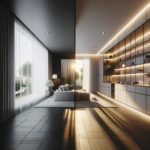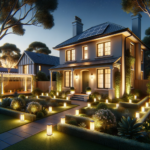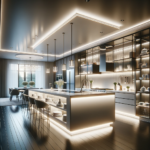Introduction

The Importance of Energy-Efficient Lighting

Energy-efficient lighting is crucial in today’s world due to its significant impact on reducing energy consumption and minimizing environmental footprint. By adopting energy-efficient lighting solutions, we can contribute to conserving resources, combating climate change, and promoting sustainable practices.
Lighting accounts for a substantial portion of electricity usage in homes, businesses, and public spaces. Therefore, optimizing lighting efficiency is an effective way to reduce overall energy consumption.
LED Lighting as a Cost-Effective and Long-Lasting Solution
LED lighting has emerged as a highly advantageous option for both residential and commercial applications. LEDs (Light Emitting Diodes) are semiconductor devices that convert electrical energy into visible light efficiently.
Compared to traditional lighting technologies like incandescent or fluorescent bulbs, LED lights offer numerous benefits. They consume significantly less electricity while producing the same or even brighter illumination levels.
Additionally, LED lights have an exceptionally long lifespan compared to other options available in the market. Overall, LED lighting stands out as a cost-effective solution that not only reduces energy bills but also lowers maintenance costs due to its extended durability.
Moreover, it provides better quality illumination with customizable options such as color temperature and dimming capabilities. With these advantages combined, LED lighting has become the go-to choice for individuals and organizations seeking an efficient and long-lasting lighting solution that aligns with their budgetary needs without compromising on performance or sustainability goals.
Understanding LED Lighting

A Revolutionary Lighting Technology:
LED technology revolutionizes traditional lighting options. LEDs emit light through the movement of electrons in a semiconductor material, unlike incandescent bulbs that rely on heating a wire filament until it glows. This difference in technology leads to numerous advantages.
Definition and Working Principle:
The Light Emitting Diodes (LEDs) are semiconductor devices that convert electrical energy into light efficiently. When an electric current flows through the LED, electrons combine with electron holes, releasing energy in the form of photons. This process called electroluminescence enables LEDs to produce visible light.
Comparison with Traditional Lighting Options:
Comparing LED lighting with incandescent, fluorescent, and halogen lights reveals substantial differences in efficiency and performance. Incandescent bulbs convert most of their energy into heat rather than light, resulting in low efficiency. Fluorescent lights rely on gas discharge and phosphor coating to generate light but have limitations concerning color quality and environmental impact.
Halogen lamps have a shorter lifespan due to the high operating temperatures required for their operation. In contrast, LEDs offer significant advantages such as higher energy efficiency, longer lifespan, instant illumination without warm-up time or flickering issues, and superior color rendering capabilities compared to traditional lighting technologies.
The Benefits of Upgrading to LED Lighting
Cost Savings
Energy efficiency saves money. LEDs consume less electricity than traditional lights.
Potential savings increase over time. Longer lifespan means fewer replacements, reducing maintenance costs.
Longevity and Durability
LEDs have a longer lifespan than other lighting technologies. LEDs last significantly longer compared to incandescent, fluorescent, and halogen lights. Solid-state design and absence of filaments contribute to LED longevity.
The absence of filaments also reduces the risk of breakage due to shock or vibration. Minimizing the need for frequent replacements helps in reducing waste.
Exploring Different Types of LED Lighting Products
Residential Applications
LED bulbs provide general illumination in residential settings, offering efficient and long-lasting lighting solutions. A19 bulbs, for example, are the most common type used in lamps and fixtures throughout homes.
These bulbs have a standard screw-in base that fits into most light sockets. BR30 bulbs, on the other hand, are designed for recessed lighting fixtures commonly found in kitchens and living rooms.
These bulbs provide directional lighting with a wider beam angle to evenly illuminate larger areas. In addition to LED bulbs, there are decorative fixtures available with integrated LEDs that add both style and functionality to residential spaces.
Chandeliers equipped with integrated LEDs offer elegant lighting options while reducing energy consumption and maintenance needs. Sconces with integrated LEDs provide accent lighting along hallways or as bedside lights, adding a touch of sophistication to any room.
Commercial Applications
LED tubes serve as excellent replacements for traditional fluorescent tubes in commercial spaces such as offices and retail stores. These tube lights not only offer energy savings but also have a longer lifespan and better color rendering capabilities compared to fluorescent alternatives. They come in various sizes (e.g., T8 or T5) to fit different fixtures.
High bay LEDs are ideal for illuminating large indoor spaces like warehouses or manufacturing facilities where high ceilings require powerful overhead lighting. These energy-efficient options emit bright light while consuming less electricity compared to traditional high-intensity discharge (HID) lamps.
For outdoor commercial applications, LED floodlights provide powerful illumination for security purposes or highlighting architectural features of buildings. Streetlights equipped with LEDs offer increased visibility on roads while reducing energy consumption and maintenance costs compared to conventional streetlights.
LED parking lot lights ensure well-lit parking areas while providing significant energy savings for businesses. With these diverse options available, upgrading to LED lighting can bring significant benefits both in residential and commercial environments.
Tips for Choosing the Right LED Lighting
Evaluating Lumens vs Watts: Understanding
When selecting LED lighting, consider lumens over watts to determine brightness. Lumens measure the amount of light emitted, while watts indicate energy consumption. Opt for higher lumen values to ensure ample illumination.
For example, a 60-watt incandescent bulb typically produces around 800 lumens, so aim for an LED bulb with a similar lumen output. It is crucial to note that LED technology is more efficient and can produce the same or greater brightness with fewer watts.
Conclusion
Upgrading to LED lighting offers significant benefits in terms of cost savings and longevity. LED technology provides energy efficiency and reduces utility bills due to its lower electricity consumption.
The long lifespan of LEDs minimizes maintenance costs and waste by reducing frequent replacements. When choosing LED lighting, prioritize lumens over watts to ensure adequate brightness for your needs.
Overall, embracing LED lighting not only helps conserve energy but also contributes to a sustainable future while enhancing your space with quality illumination. Remember that every step we take towards energy efficiency brings us closer to a greener planet and a brighter future for generations to come.
By embracing the advantages of LED lighting, we are making a positive impact on both our wallets and the environment. So let’s upgrade our homes and businesses with these cost-effective and long-lasting solutions for a brighter tomorrow!









